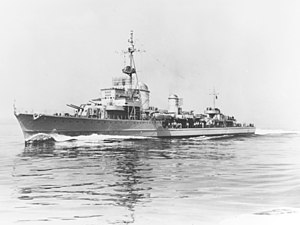German destroyer Z37
 Sister ship Z39 underway after the war
| |
| History | |
|---|---|
| Name | Z37 |
| Ordered | 19 September 1939 |
| Builder | Germaniawerft, Kiel |
| Yard number | G627 |
| Laid down | 2 January 1941 |
| Launched | 24 February 1942 |
| Completed | 16 July 1943 |
| Captured | 6 May 1945 |
| Fate | Scuttled, 24 August 1944; Scrapped , 1949 |
| General characteristics (as built) | |
| Class and type | Type 1936A (Mob) destroyer |
| Displacement |
|
| Length | 127 m (416 ft 8 in) ( o/a ) |
| Beam | 12 m (39 ft 4 in) |
| Draft | 4.62 m (15 ft 2 in) |
| Installed power |
|
| Propulsion |
|
| Speed | 36 knots (67 km/h; 41 mph) |
| Range | 2,950 nmi (5,460 km; 3,390 mi) at 19 knots (35 km/h; 22 mph) |
| Complement | 316–335 |
| Armament |
|
Z37 was a
Design and description
The Type 1936A (Mob) destroyers were slightly larger than the preceding Type 1936A
The Type 1936A (Mob) ships were armed with five
Modifications
Another quadruple 2 cm mount replaced the forward single 2 cm gun sometime after early 1943.[8] The ship was fitted with a FuMB Metox radar detector after commissioning.[9]
Service history
Z37 was first ordered from Oderwerke Stettin as a
On 23 January 1943 Z37 set out as part of the escort for the battleship
On 28 March, Z37 was one of four destroyers that formed the distant escort for the Italian blockade runner Himalaya setting out from Bordeaux for the Far East, with 9 torpedo boats providing a close escort, but the force turned back when spotted by British air reconnaissance. On 30 March, Z37, together with the destroyers Z23, Z24 and Z32, set out to meet the incoming blockade runner Pietro Orseolo. Heavy British air attacks were repelled, but Pietro Orseolo was damaged by a torpedo from the American submarine Shad before reaching safety in the Gironde estuary on 2 April. On 9 April, Z37 set out on another attempt to cover the break out of Himalaya, but again this was foiled by British air attacks.[16]
On 24 December 1943, six destroyers of the 8th Destroyer Flotilla (Z37, Z23, Z24, Z27 and ZH1) and the 4th Torpedo Boat Flotilla (of six torpedo boats) set out to meet the blockade runner Osorno, meeting her on 25 December. They managed to escort Osorno to the Gironde despite heavy air attack, but Orsono struck a submerged wreck and had to be beached to save her cargo.[17] On 26 December, the 8th Destroyer Flotilla, again including Z37 (but without ZH1) and the 4th Torpedo Boat Flotilla set out again to meet another inbound blockade runner, Alsterufer. Unbeknownst to the Germans, Alsterufer was attacked and set on fire by a B-24 Liberator bomber of No. 311 (Czechoslovak) Squadron RAF on 27 December and was abandoned by her crew. At about midday on 28 December, the British cruisers Glasgow and Enterprise, on patrol in the Bay of Biscay to intercept blockade runners, encountered the German destroyers and torpedo boats, resulting in the Battle of the Bay of Biscay. Heavy seas prevented the German force from using its theoretical advantages in speed and firepower, with the destroyer Z27 and the torpedo boats T25 and T27 sunk. Z37 fired six torpedoes against the British cruisers, all of which missed.[18][19]
On 30 January 1944, Z37 was carrying out exercises in the south of the Bay of Biscay with Z23 and Z32 when she collided with Z32. One of Z37's torpedoes exploded, starting a fire which set off some of her anti-aircraft ammunition and caused extensive flooding. She was towed back to Bordeaux, but the damage was considered too severe for repair, and her guns were removed to strengthen the shore defences of the Gironde estuary, with her crew being deployed as ground troops. She was decommissioned on 24 August and then scuttled. Her wreck was broken up in 1949.[20][21]
Citations
- ^ Gröner 1990, p. 204.
- ^ Koop & Schmolke 2014, p. 27.
- ^ a b Koop & Schmolke 2014, p. 117.
- ^ Sieche 1980, p. 234.
- ^ Whitley 1991, pp. 68, 71–72, 201.
- ^ Gröner 1990, p. 203.
- ^ Friedman 1981, pp. 205–206.
- ^ Whitley 1991, p. 73.
- ^ Koop & Schmolke 2014, p. 40.
- ^ Koop & Schmolke 2014, pp. 24–25.
- ^ Whitley 1991, p. 207.
- ^ Koop & Schmolke 2014, pp. 24, 116.
- ^ Rohwer 2005, pp. 227–228.
- ^ Koop & Schmolke 2014, p. 72.
- ^ Rohwer 2005, p. 236.
- ^ Rohwer 2005, p. 241.
- ^ Rohwer 2005, p. 294.
- ^ Rohwer 2005, p. 295.
- ^ Koop & Schmolke 2014, pp. 72–73, 117.
- ^ Rohwer 2005, pp. 303, 348.
- ^ Koop & Schmolke 2014, pp. 74, 117.
Books
- ISBN 0-85177-238-2.
- ISBN 0-87021-790-9.
- Koop, Gerhard & Schmolke, Klaus-Peter (2014). German Destroyers of World War II. Barnsley, UK: Seaforth Publishing. ISBN 978-1-84832-193-9.
- ISBN 1-59114-119-2.
- Sieche, Erwin (1980). "Germany". In Chesneau, Roger (ed.). Conway's All the World's Fighting Ships 1922–1946. London: Conway Maritime Press. pp. 218–254. ISBN 0-85177-146-7.
- ISBN 978-1-55750-302-2.
